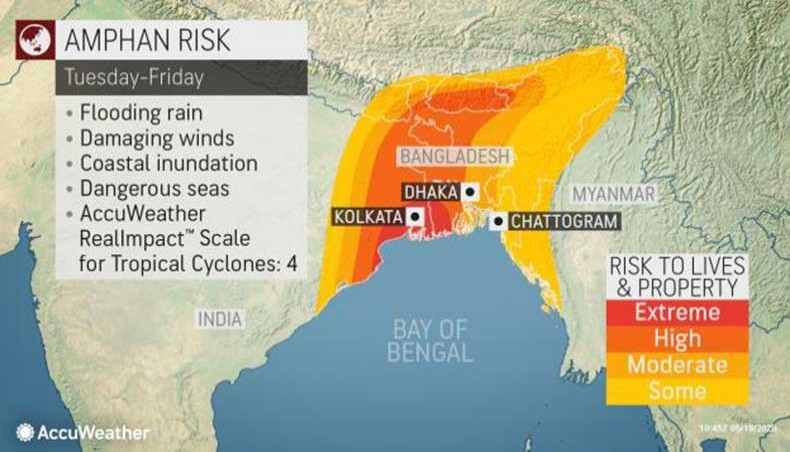Massive evacuation as Amphan approaches
The country braces for the super cyclone Amphan after it rapidly intensified over the last couple of days and is likely to make landfall between afternoon and evening today.
As drizzling broke out in the afternoon in the coastal areas and parts of central Bangladesh amid an otherwise eerie calm that descended on these regions on Tuesday, the government continued with the massive evacuation drive moving more than 2 million people to cyclone shelters amid the risks of novel coronavirus infections.
The cyclone that lay 650 km away from the Payra port over the west central bay until 7:30pm on Tuesday and moved with wind within 85 km of its centre, blowing up to 220 km per hour, is due to make landfall between West Bengal and Bangladesh.
Weather forecasters called the storm the strongest ever recorded in the Bay of Bengal since the 1999 Odisha cyclone while predicting it would bring catastrophic rains, tidal surge flooding and hurricane-strength winds.
‘What we feel now is the lull before the storm,’ meteorologist Abdul Mannan told New Age around 5:30pm, referring to the unusual stillness in the air amid light rains.
The storm is likely to hit Bangladesh with hurricane-strength winds blowing up to 160 km per hour, he said.
About an hour and half before the state minister for disaster management and relief, Enamur Rahman, announced through an online press conference that the great danger signal number 10 would be hoisted at 6:00am today.
‘We are busy tackling the coronavirus crisis when the new danger looms over our head,’ said Enam, adding that armed forces, members of NAVY, and other government agencies were racing against the time to complete the evacuation of 22 lakh people to 12,078 cyclone shelters by Wednesday morning.
‘The evacuation would continue throughout the night,’ he said.
About 35,000 people have been evacuated by 5:00pm, according to the disaster management and relief ministry.
The Bangladesh Meteorological Department maintained danger signal number seven for the maritime ports of Mongla and Payra and coastal districts such as Satkhira, Khulna, Bagerhat, Jhalokathi, Pirozpur, Barguna, Patuakhali, Bhola, Barishal, Laxmipur, Chandpur and their offshore islands and chars.
The maritime ports of Chattogram and Cox’s Bazar were advised to keep hoisting the danger signal number six.
The coastal districts of Noakhali, Feni, Chattogram, Cox’s Bazar and their offshore islands and chars were put under the danger signal number six as well, said the BMD.
‘People always seek shelter at the 11th hour,’ said Swapan Kumar Brahma, the district relief and rehabilitation officer, Bagerhat.
Bagerhat plans to evacuate 2 lakh people to 677 cyclone shelters but only 3,000 were there until late afternoon.
Swapan was not worried at all about the poor turnout of evacuees saying that they spread the word that a dangerous cyclone was making its way towards Bangladesh.
He said that people would come making their own arrangements.
Bangladesh Inland Water Transport Corporation suspended ferry services over all major rivers and in coastal areas until further notice while the Chattogram Port Authority suspended all commercial activities.
The CPA secretary Omar Faruk told New Age correspondent in Chattogram that 70 ships were sent out to deep sea and lighter vessels upstream after the 2nd highest alert was issued for the port.
Low-lying areas in parts of the Chattogram city such as Halishahar, Patenga, Beri Bandh, and Outer Ring Road were inundated by higher than usual tidal surge in the afternoon.
With the weather turning inclement in places, evacuation would become difficult after nightfall, especially from remote areas, where communication is treacherous even in daylight, said said Swapan Kumar Brahma.
European weather forecaster the Severe Weather Europe said that the cyclone Amphan was world’s one of the most rapidly intensified tropical system which turned a category 5 cyclone in just 24 hours from category 1 from Sunday afternoon.
On Monday, the wind speed near the cyclone centre reached to 260 km per hour and slightly weakened on Tuesday.
The European weather forecaster said that the cyclone might cause rain up to 400 mm in some places.
The US-based AccuWeather said that the cyclone is taking the path that the world’s fifth deadliest tropical cyclone had taken in 1991, killing 1,38,866 people in Bangladesh.
AccuWeather said that the cyclone would rapidly lose intensity after making landfall but still it would be a very strong cyclonic storm.
The super cyclone category was introduced in 1999 after an unusually strong storm developed in the Indian Ocean with 260 km per hour winds that eventually killed 10,000 people in Odisha.
In a special weather bulletin, the BMD said that the cyclone was 775 km southwest of Chattogram port, 730 km southwest of Cox’s Bazar port and 660 km south-southwest of Mongla port until 7:30pm.
The cyclone is likely to move in north-northeasterly direction and cross Bangladesh coast between Khulna and Chattogram.
Tidal surges reaching five to 10 feet high above the regular astronomical tide might inundate the 15 coastal districts and their offshore islands and chars during the passage of the storm, said the BMD.
The BMD asked all fishing boat and trawlers over the North Bay and deep sea to immediately move to shelters and remain there until further notice.
India Meteorological Department said that the cyclone would make landfall between Digha and Hatiya in Bangladesh close to the Sunderbans Wednesday afternoon or evening.
New Age correspondent in Barishal and Khulna reported that people began thronging cyclone shelter centres in small numbers from afternoon as authorities used trawlers to carry people to safety from vulnerable places.
Forecasters said that the cyclone could be as strong as cyclone Sidr which packed with 260 km per hour winds killed 3,447 people in 2007 and caused damage worth of $1.7 billion.
Global Forecast System warned that the cyclone was taking the path similar to the cyclone Aila that hit in May 2009. Aila killed 339 people and caused a damage of $295.6 million.
News Courtesy: www.newagebd.net











